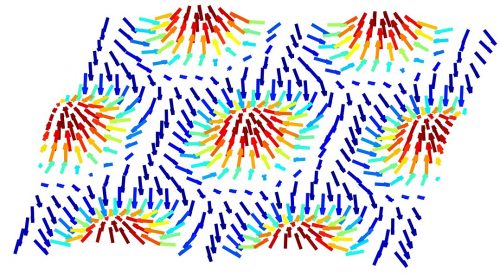The system developed at the Technion is expected to lead to the discovery of a variety of new optical phenomena

Researchers at the Technion succeeded in producing tiny "hedgehogs of light" called optical skyrmions, which hold the potential for a breakthrough in information processing, transmission and storage. The research, which was published in the prestigious journal Science, was led by Prof. Guy Bartel from the Faculty of Electrical Engineering at Viterbi and Prof. Nathaniel Lindner from the Faculty of Physics at the Technion. Prof. Bergin Jiunai from the Faculty of Medicine at the Albanian University in Tirana and the students Shai Tsass, Yevgeni Ostrovsky and Kobi Cohen participated in the study.
The term "skyrmion" is based on the name of the British physicist Dr. Tony Skyrme, who in 1962 devised a method for increasing the stability of high-energy physical systems, using tiny fields with a "hedgehog" spatial configuration. Over the years, this idea has also been realized with magnetic and other materials, and today the skyrmions are considered a great promise - partly in increasing the storage volume of computer memories.
Today, most of the information in the world is stored on hard drives, which are read from by a mechanical arm. Information management using skyrmions, on the other hand, is based on non-mechanical movement of the skyrmions using weak electric currents. Another feature of the skyrmions is their tiny size - they are 10,000 times smaller than the diameter of a hair. These characteristics are expected to dramatically optimize, speed up and reduce information processing, transfer and storage processes.
Technion researchers are the first to expand Dr. Skiram's idea to the field of optics; They were able to create skyrmions using the electric field of electromagnetic waves moving through special materials. Unlike "normal" light waves, whose electric field is usually oriented in a specific direction (a physical principle on which, for example, polarizing sunglasses are based), the Technion researchers showed that the electric field can take on the "skyrmion" shape and address all the Hebrews at the same time so that its shape The space resembles the spines of a hedgehog. Furthermore, they showed that those "hedgehogs of light" are not affected by defects in the material in which they were created.
Success in creating skyrmions in electromagnetic waves may be of crucial importance in practical applications. Today, materials in which skyrmions are formed are extremely rare and require cooling to very low temperatures, usually using nitrogen or liquid helium. The new discovery may in the future create this unique phenomenon in a variety of systems and materials such as liquids, nanoparticle arrays and gases of cold atoms. The research may also lead to new applications of skyrmions in information processing, its transfer and storage in optical and non-magnetic ways.
The research was conducted in collaboration with the Sarah and Moshe Zisafel Center for Nanoelectronics and the Russell Berry Institute for Research in Nanotechnology and with the support of the Jacobs Foundation, the I-CORE Center of Excellence, the Israel Science Foundation (ISF) and the European Research Council (ERC).
For the article in Science: click here

5 תגובות
The drives these days are SSD and have a PCI-E interface. The named drives are for files that are almost never accessed
The article also in
https://arxiv.org/ftp/arxiv/papers/1805/1805.11839.pdf
If we add Wolf Prize winners - there are also such at the Technion.
The next Nobel was marked - Motti Segev won Wolf 2014, but we quarreled with the Norwegians so there might not be a chance.
Nathaniel Lindner is a young professor among the young or at least it seems that way - almost a child. Winner of the Krill Award from the Wolf Foundation.
The Technion takes the best at least in physics. Can the institution afford - heavy and numerous donations. 5 centers that research quantum. 3 Nobel laureates: Hershko and Taschenover, Gross. One research center in New York and maybe (can't remember) something in Asia.
In the competition in New York he beat elite universities in the USA.
Those who look at Nathaniel's publications: extremely complex on the subject of condensed matter physics, excellent theory. Maybe young, but already surrounded by postdoctoral and doctoral students.
I think he is also a member of I-CORE, the association of excellence of all universities in the field of optics. The head of the I-CORE group, in my opinion, is Moti Segev, and its member is Yonina Elder, a member of the Israeli Academy of Sciences.
A very important article on quantum computing and the urgent need to move there came out this week. Envy of writers will breed wisdom. There were articles on the subject here as well.
Well done !! ..the scientists. They are the real warriors that no one appreciates.. Everyone just thinks about army and police and terrorism....
Believe me, you are worth more than anyone. Well done and I appreciate it very much.. If I had huge sums I would finance you but unfortunately I don't have it
Good Day .